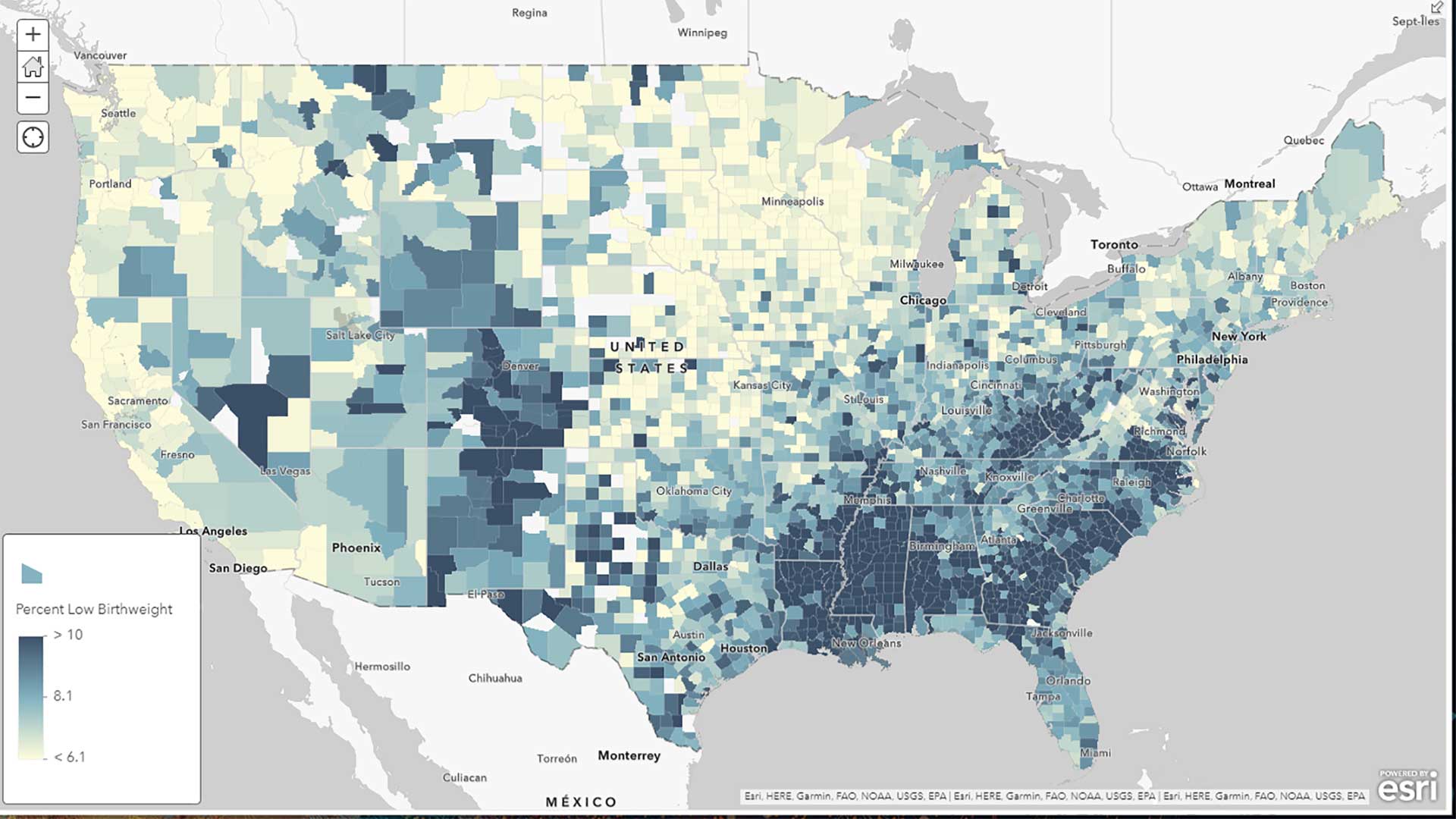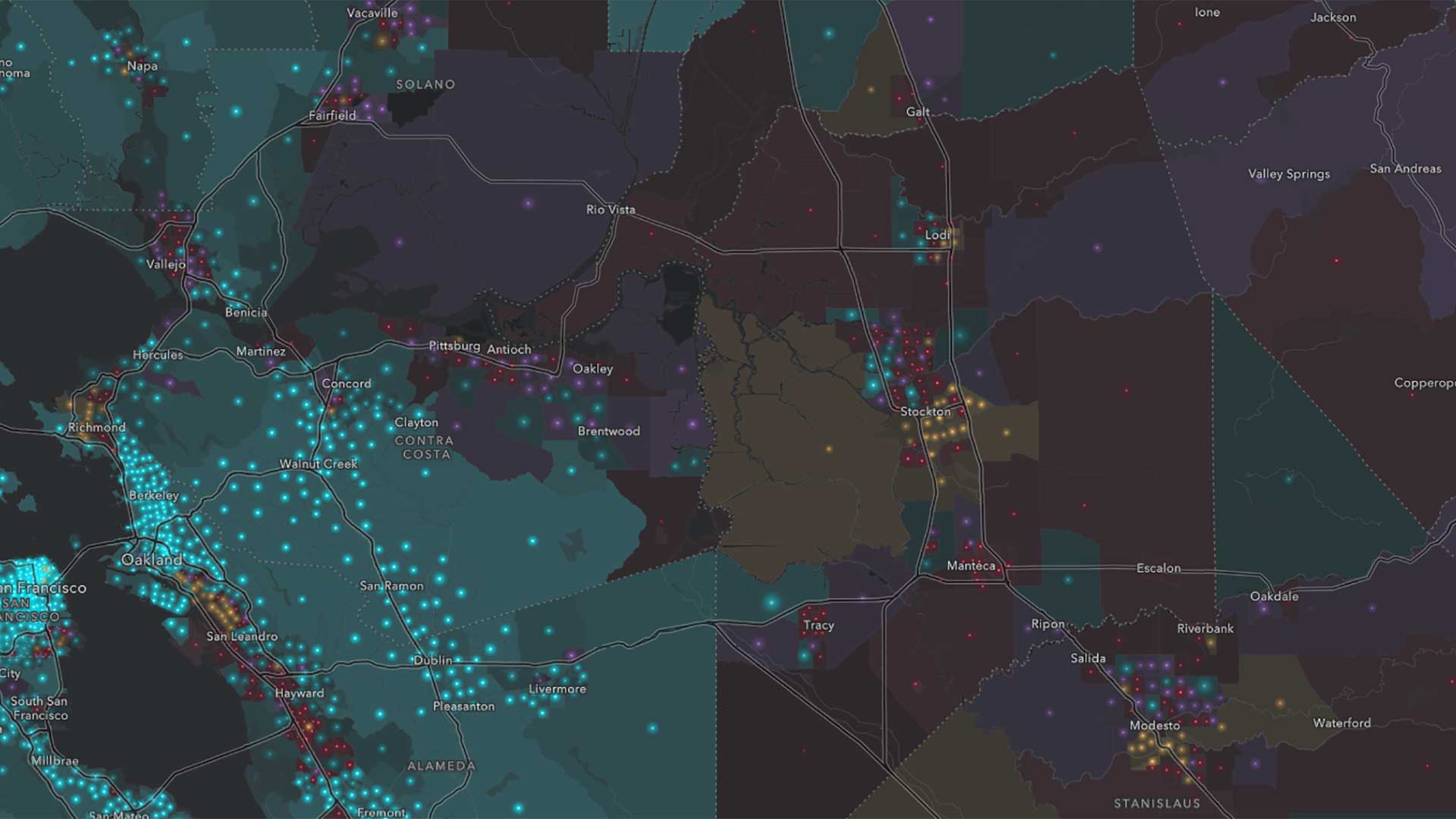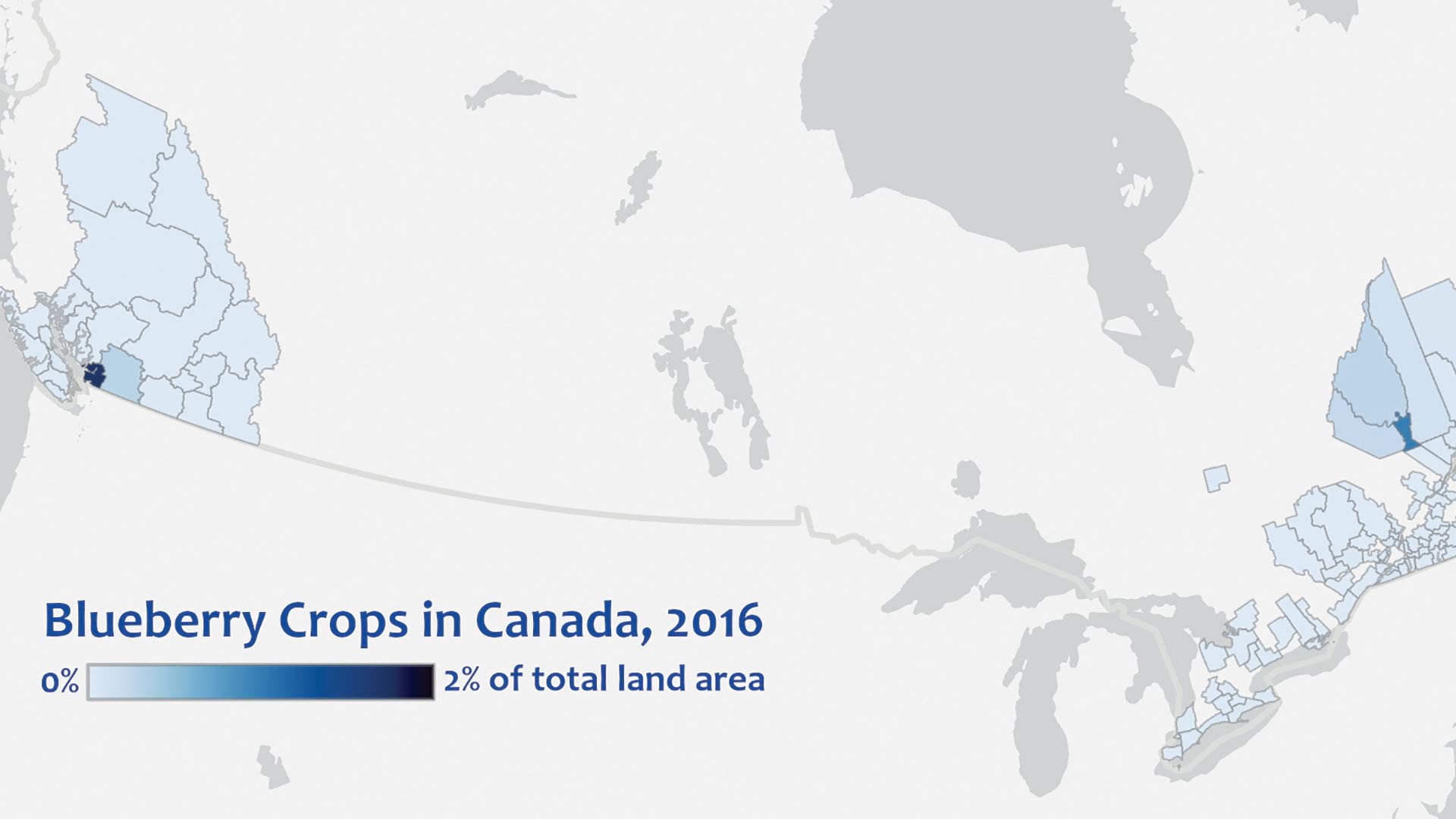So many times, tutorials depict the mapmaking process as a guided and regimented step-by-step process, but this isn’t what the process is like at all.
Every great map starts with a purpose. But how can you choose a purpose for your map if you don’t understand the data? After spending an incredible amount of time finding, processing, and analyzing data, you can run out of energy by the time you need to use it to tell your story.
In most cases, you have no idea what to expect from the data. You might find this unsettling, but it can be an opportunity to create a map with a new perspective.
Anyone can drop some data onto a map and call it a day. The internet is full of maps like that. Don’t do that. Ask more of the data and of yourself. Challenge yourself. Take an extra five minutes (or more) to explore your data in ArcGIS Online. This exploration can lead to better maps, more informed cartographic decisions, and more meaningful narratives about the data you spend so much time preparing.
For example, you may want to better understand which parts of the country are at higher risk when evacuation orders are necessary in response to natural disasters such as hurricanes, fires, or floods. Or perhaps you are interested in visualizing patterns related to poverty, non-English-speaking populations, and households without a vehicle because these are indicators of populations that are at risk during evacuations, when time is short and every minute counts.
Here are some easy ways to explore a spatial dataset you have never seen before. You can follow along by opening the ACS Context for Emergency Response—Boundaries web map that is available from the ArcGIS Living Atlas of the World in ArcGIS Online. This layer contains demographic data from the most recent American Community Survey (ACS)that is provided by the US Census Bureau.
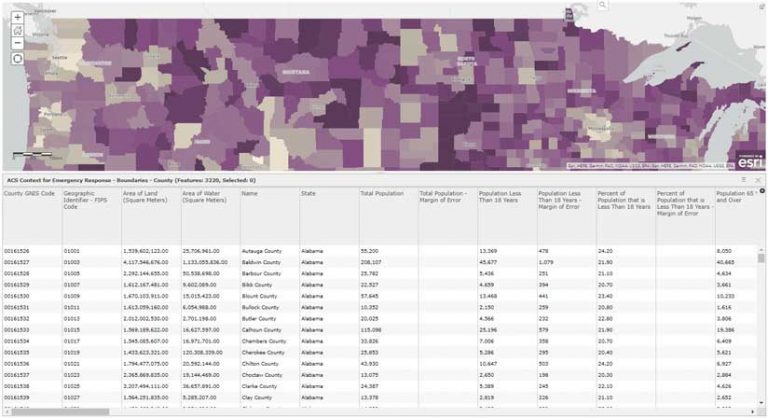
Open this layer and you will see three layers—state, county, and tract—in the table of contents. Start by viewing the counties to see what nationwide patterns emerge during data exploration. Change the basemap to Light Gray Canvas. When you explore the data on a neutral light gray basemap, the colors won’t compete with the basemap as you try new things.
Browse the Attributes
Although this may sound obvious, browsing attributes is the foundation of your understanding of a dataset. Because this dataset was created by a government agency, it won’t be as familiar as a dataset you created yourself.
Start exploring the table to see the types of fields (numbers, dates, categorical) it contains. Get a sense of how many records the database contains. This layer has data on 3,220 counties in the US, including Puerto Rico and Washington, DC. As you scroll through the table horizontally, you will see most attributes are numeric. They cover a wide range of demographic topics that are related to at-risk populations.
Another way to explore the data is to explore the item page for this web map on ArcGIS Online. From the Boundaries – County layer in the map’s Contents pane, click the More Options icon and choose Show Item Details. A well-documented item page will provide context for the data source and any constraints on its use (if they exist).
If you choose the Data tab, you can see the table by default. Toggle from Table to Fields to see each field, its alias, the long description, and field type for each attribute. Scroll to the right to find the attribute named Percent of adults 18 years and over who have limited English ability. This attribute represents the population who sometimes or always speak a language other than English at home. They may be at higher risk during evacuation orders because they may not understand evacuation orders provided in English.
Use smart mapping to immediately see patterns in the map. It’s called “smart” because no matter what attribute you choose, the software recognizes the data type, such as numeric or date, and offers mapping options specific to the data type, making it easy to quickly choose different attributes and try mapping styles that are appropriate.
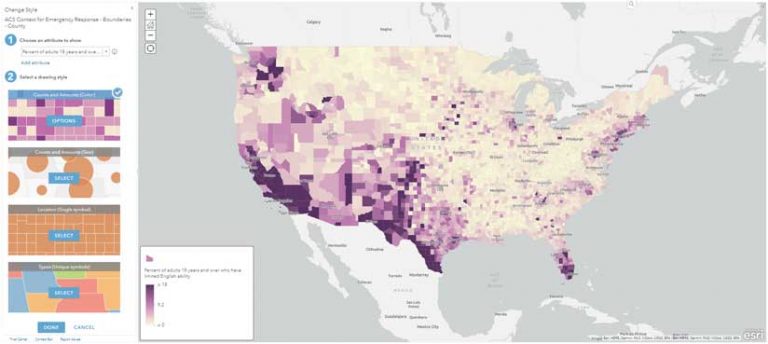
Although an attribute table helps you see the fields and the values in them, you can often get a better sense of these fields by mapping them. Click Change Style for the County layer and choose an attribute to show. Find the attribute “Percent of adults 18 years and over who have limited English ability.” Since this is a numeric attribute, Counts and Amounts (Color) is the default mapping style. The map shows the location of distinct areas that have at-risk populations.
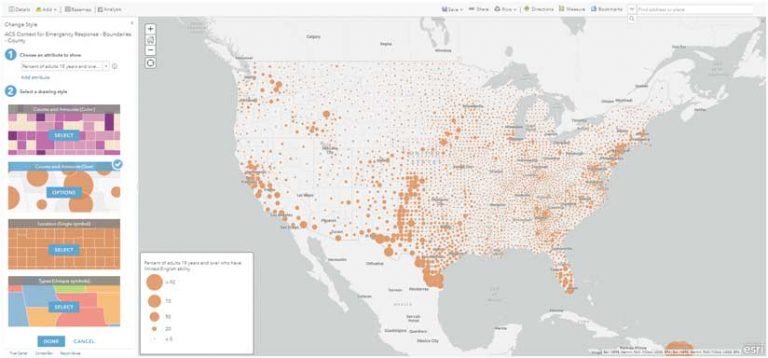
Switch to the Counts and Amounts (Size) option. There is still a pattern, but it is a bit harder to differentiate areas with at-risk populations. Click the Options button to see the distribution of data values. It shows an outlier is reducing the variation of symbol size in this map. To overcome this, drag down the upper handle and see how the symbol sizes change.
In general, percentages work well when mapping with color, but size is usually more appropriate to use when mapping a count such as the number of adults 18 years and over with limited English proficiency. Trying different styles helps you decide how to map this attribute.
Since it is easy to try different attributes and styles, spend a few minutes scrolling through the list of attributes and mapping different attributes that you find interesting. You may be surprised at what you find. You don’t need to have a plan, but this initial discovery should help inspire you to get started. You may even discover another attribute that helps support your map’s purpose.
Tip: If you don’t know what the attribute means, click the “i” icon next to the attribute to see the long descriptions that are included for each attribute in this layer.
Let Statistics Tell You Something
Smart mapping in ArcGIS Online not only recognizes the types of attributes and offers appropriate mapping suggestions, it also shows you statistically significant patterns by default.
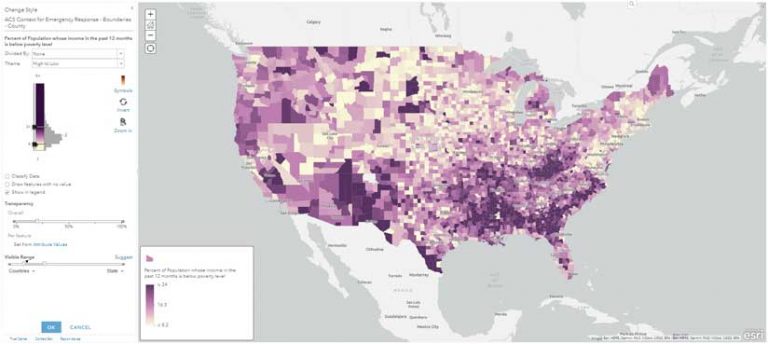
If you choose a numeric attribute and choose map by color, the map will automatically highlight areas in your data that are plus or minus one standard or significant deviation, which makes it easy to quickly see patterns. Explore another at-risk group in this layer by finding the attribute “Percent of Population whose income in the past 12 months is below the poverty level.” Click the Options button to see the histogram for this data.
Simply by choosing an attribute of interest, you can learn which parts of the country have significantly high rates of poverty (i.e., a rate of more than 24 percent). These areas are shown in the darkest shade of purple.
You can also use these statistics by trying out different themes. Themes can help emphasize significant patterns by drawing focus to outlier values or values that make up the bulk of the data.
If you use the Above and Below theme on your map, it will adjust the colors to show which parts of the country are either above or below the average value for poverty for counties, which is 16 percent. This emphasizes areas of need, shown in orange.
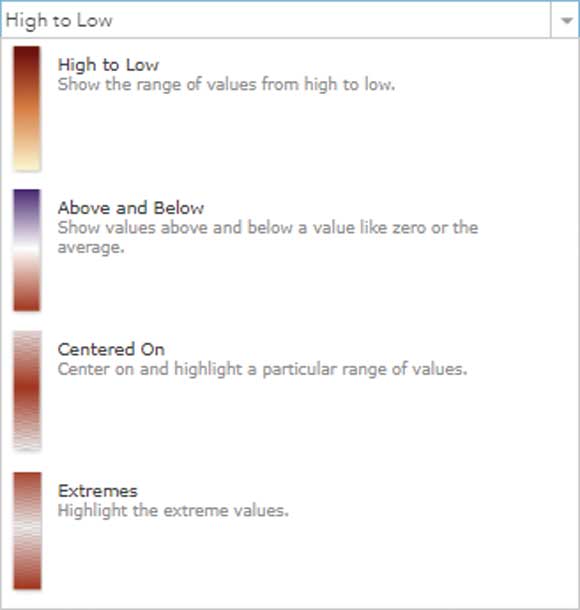
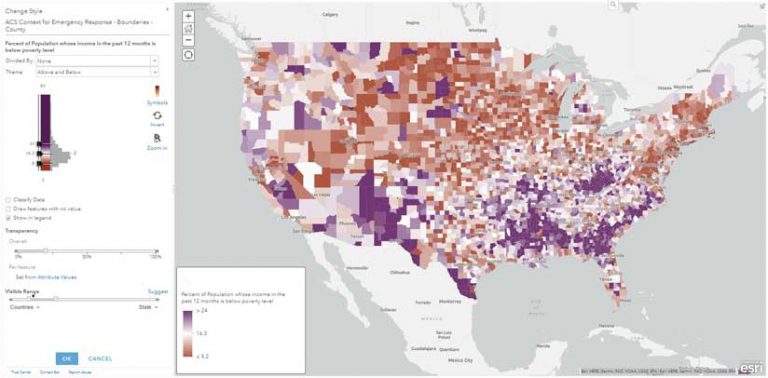
Don’t Be Afraid to Try Things (and Sometimes Fail)
This may be the most important step in data exploration. If you limit yourself to the defaults that are given, you may never reveal the most interesting patterns hidden in your data. The Options button is your best friend and will open a world of possibilities and tools for exploring. You won’t make the perfect map in your first few clicks and don’t be afraid to make some ugly maps along the way.
Try different basemaps, color ramps, symbols, and themes and have some fun while you are doing it. Through this process, you can end up with multiple maps you like. Save each one and you might notice that the same attribute can be shown in very different ways.
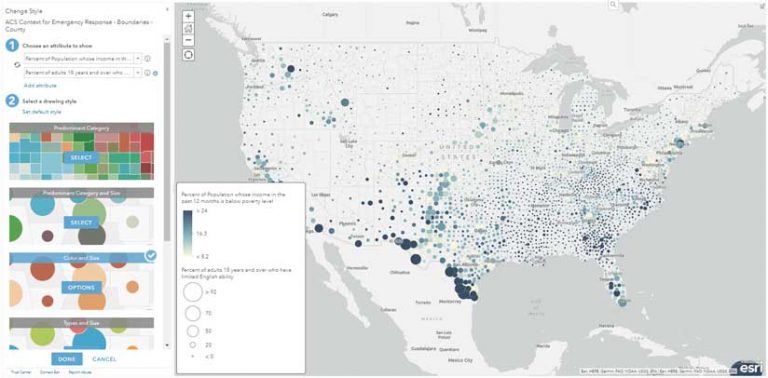
Try Mapping Multiple Attributes
Once you’re feeling comfortable with your data and the tools, start thinking about the connections between the different attributes in your data. The two attributes, Percent of households with no vehicle available and Percent of adults 18 years and over who have limited English ability, could be related because in an emergency these could be important attributes to map together since they both present at-risk populations.
Smart mapping also knows what to offer you when you choose two (or more) attributes. These are two numeric attributes, so smart mapping offers color and size, predominance, and relationship styles. Try each one and compare the patterns. See what relationships emerge. Not every option will provide a useful map, but you may see some interesting things along the way. It’s all part of the data exploration process.
Here are some more data exploration tips:
- The Color & Size option is good for showing a count and a normalized version of that count. For example, the color can show the percent of poverty and size can show the number of people in poverty.
- Predominance works best when comparing multiple numeric attributes that are counts. For example, an election map compares the count of voters for each party.
- Relationships are a powerful way to compare the patterns of two different numeric attributes such as the counts or percentages for two attributes.
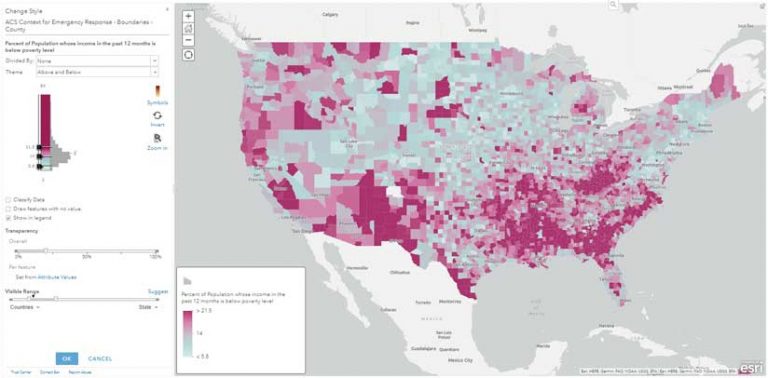
Use Your Knowledge
While technology can help you make better maps, nothing beats the power of the human mind. Smart mapping can get you most of the way there and help you learn new things, but your own knowledge of the world is your most powerful tool.
As you get closer to deciding your map’s purpose, bring meaning to your map by establishing if there are values that anchor the map or provide context for it. For example, if you mapped the percent of households in poverty for an area and discover that the value is 16 percent, that is a good start.
However, if the map will be released with a report that references the national average, which according to the ACS is 14 percent, you need to add context and create consistency with the report. Use the Above and Below theme and to center the map around the national average instead of the county average. This gives the map a solid anchor point. Areas below the national average are one color and areas above the national average are in another color, clearly showing areas of deep poverty.
The national average is just one way to anchor the map. Using the same technique, you can set the center color around a threshold, goal, or other meaningful number to create deeper meaning for the colors in your map. If you were interested in showing areas in which more than 10 percent of people are in poverty, you could use the number 10 to anchor the map.
Always Search for Great Maps
Now, zoom in to a city where you see the census tracts, and use the techniques you just used to explore new patterns. Try using different attributes or use the same ones and see what the pattern reveals about a local area.
You should realize that turning data into a purposeful map is a journey, not an event. Making one good map should lead to better questions, which leads to other good maps. It’s a virtuous cycle you use to improve your mapmaking.
Putting data on a map is only the beginning because your map has no purpose, only data. A map gains purpose as the mapmaker begins to understand the data, explores it, asks questions of it, and modifies the map based on answers to those questions.
To learn more about how to add purpose to your map, see the accompanying article, “Mapping with Purpose” in this issue.


